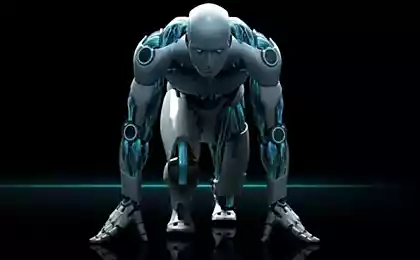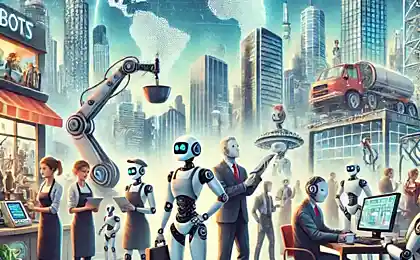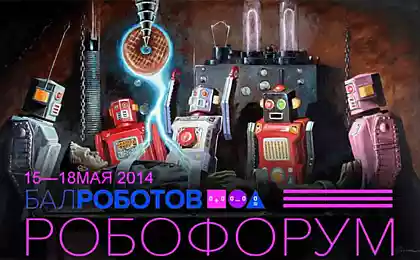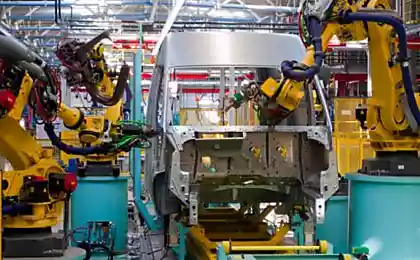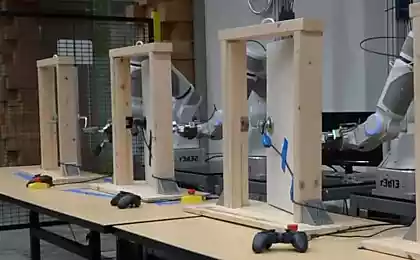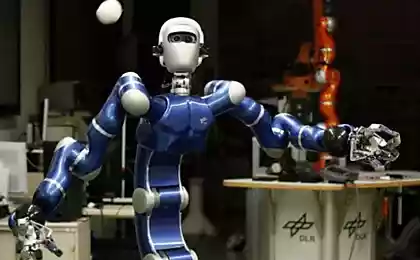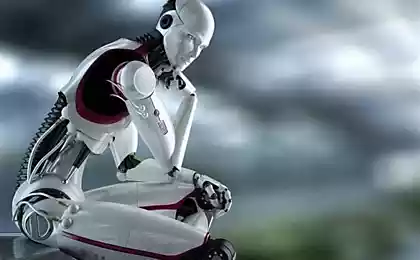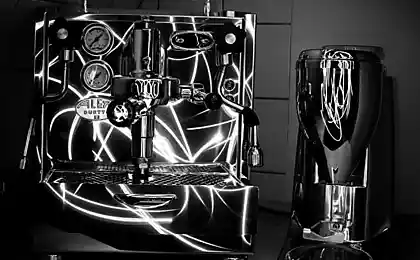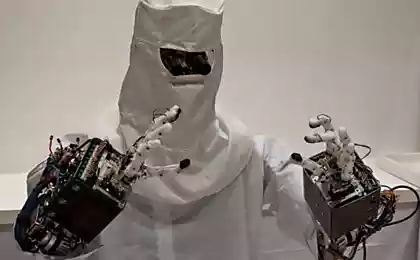1442
Robots in production. Machinery and we [02]
Why today is very important to pay attention to such popular notions as big data, robotics, artificial intelligence, and all these attempts to teach machines to do more interesting things? It would seem that all this toy for geeks. Why is it just as important and perhaps even more than nanotechnology?
Scientists who study the history of innovation, come to the conclusion that there are certain patterns in the innovative development of society. Every single time can be described S-curve on which there are periods of slow initial distribution, rapid and widespread decay. With these phases and cycles converge about economic growth, and found that Kondratiev. Study questions the theory perfected and now, one of the plurality of opinions can be described five waves of innovation (technological structures). Now we are on the threshold of the sixth order, the picture below shows the approximate time frame and related technologies:
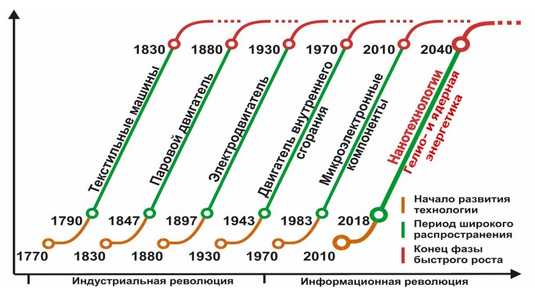
The sixth wave of innovation is designated as the development of nanotechnology and nuclear power. Apparently, this forecast was chosen as a basic for the technological development of Russia, legs and RUSNANO project " Breakthrough "just grow out of it. Unfortunately, probably guessing about the timing and dynamics of the new structure, the forecast , in our humble opinion, coarsely missed in choosing technology. Under the scheme, since the end of the twentieth century, the information revolution begins with what we can not agree, whereas for the sixth order are chosen, for some reason, not information technology.
If we look at the current landscape of technology and think that now can change our lives as well as the steam engine and the microchip, we arrive at the conclusion that these are the information technology geeks. Let's see an example of one of the most sensational of this technology: the car-robot that can move without human intervention, created largely thanks to the symbiosis of machine learning and analyzing the huge amount of data. For example, here is a well-known, reminiscent smile Google car, behind which is already 1, 1 million kilometers in a technical prototype.

According to the estimates of their creators, he сократит the number of accidents and lost in suburban travel time by 90%. We add that the annual death rate from road accidents in the world is more than 1 million people, and the children is the main cause of death. If the machine will no longer be private transport, and become public, we can expect fold reduction in the vehicle fleet, because utilization of private cars is very low. In the example below you can see that even in the rush hour at most 17% cars are on the roads at the same time:
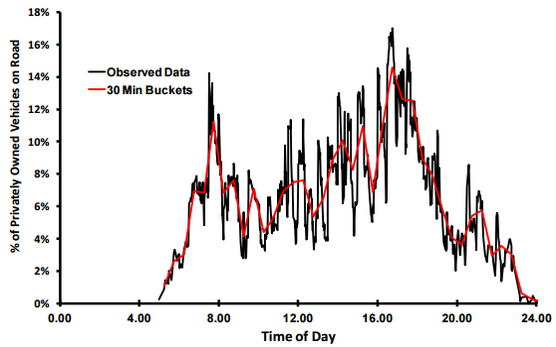
The horizontal - the time of day, vertical - the share of private vehicle to the road i>
The transition from private car to the taxi-robomobilyu will reduce the required number of vehicles, increasing their overall utilization, while less expensive cost of transportation. On the one hand, "public robomobilyu" confronts the inertia of human thinking, but on the other study показывают, it is commonplace in the cheaper one, 5-10 times and more convenient. Plus it west is the starting point of many social breakthroughs, such as open source software or human rights. Is a good tool and state regulation - for example, in Norway quarter selling cars - electric cars, and there is a car in Manhattan only every fourth жителя and the main transport - taxi.
All this leads to a change in optimal performance cars: instead of the usual five-seater petrol sedans, and for the United States and instead of pickups, relevant double mini-cars like the image above. They are cheaper to manufacture and require less energy to transport to and from work, which makes electricity for these vehicles is much more interesting option than it is now.
Inevitable and structural effects in the economy, the whole industry will become less relevant: it will take fewer gas stations, repair shops, car washes, insurance agents and insurance companies themselves, one of the automakers go bankrupt, or switch to the production of exclusive models for connoisseurs. Hospitals will be free, as will lose hundreds of thousands of patients; vacate the area occupied by parking lots - it will free space in cities for alternative uses; change the logistics industry - reduce the demand for the profession of drivers of all kinds, including couriers and trucks.
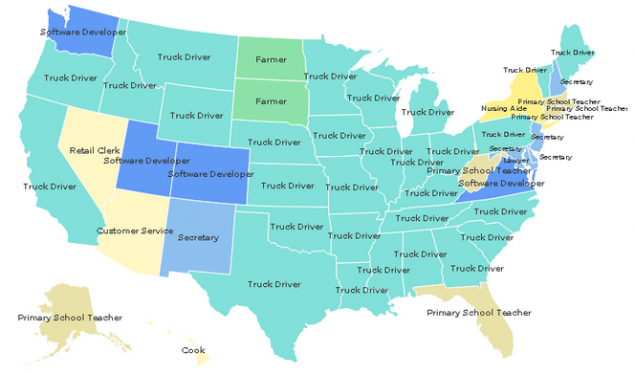
The most popular profession in the states (pale blue color truck drivers) i>
As a result of all these releases millions of workers and trillions of dollars in potential savings - you can conquer Mars and build undersea cities. Well, if you are a pessimist, we are waiting for millions of poor and unemployed, slipping into gangs and prey on robomobili privileged class. In any case, this is a truly revolutionary technology that will have an impact on society comparable to the replacement of the horse on the "Model T" from Ford. That's why this funny little car attracts the attention of economists and futurists of all kinds.
Analysts Morgan Stanley adhere to мнения, that this utopia we find ourselves in 2025, and the first fully self-contained models will be available within 3 years, in 2018. In the Audi добавляют, that in 2017 they have released a fully automatic A8, but the main problem is not technical but legal.

The development of autonomous technology TC i>
People hardly are nonexistent and especially benefit from it and consistently underestimate the possibility of progress. For those who are on the side of the monitor casually waving at our fantasies, we give examples of real commercial.
You can start with the history of confrontation between the two resource-oriented countries - Brazil and Australia. Both iron ore supply for the growing Chinese market (60% of world iron ore imports accounted for China). In Brazil, cheap labor and more saturated rock, but it is far away from China. Australia close, but has expensive labor. Competition led to optimization - Brazil reduces the cost of transportation costs through the construction of dry bulk fleet to unprecedented for its time scale of 400,000 tons deadweight. Dry cargo is so large that no port was not ready to accept them and they had to overload the ore off the coast of China's smaller ships.
Australian company Rio Tinto (third place among the world's mining companies) went through more advanced and has launched a program " mine of the future ". While Google and others are working on their prototypes, robotic autonomous 300-ton dump trucks Komatsu firms in the harsh conditions of the Australian desert has passed 4 million kilometers and transported 200 million tons of rock:
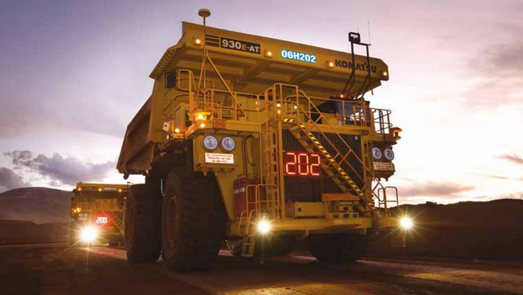
And "mine of the future" is not limited to: automatic drilling-mortgagors explosives, monitoring and control processes ore sorting, and now the program is now automated railway length of 1500 km with autonomous driverless trains. In general, these innovations helped to increase ore extraction, while saving the company 900 employees and significantly improve the working conditions of hundreds of others. It is worth noting that each truck drivers needed 4-5 with a salary of more than 100,000 dollars a year, and the driver got 240'000 dollars. The program does not stop there - expands the number of robots, trucks, etc., which will eventually lead to a decrease in the cost of technology and its spread to other mines around the world. Thus, if the success of Google's machine has yet to be proven empirically, the benefits of the truck in the picture above is already quite palpable and has a real economic result.
Despite vyshenapisannoe, predict the future no one has learned and scientific community, as always, is divided into pessimists and optimists. The former believe that the innovations of the near future are small relative to the two industrial and computer revolution and the current slow growth in labor productivity in the west will be delayed. The latter rely on the fact that mankind has always underestimates the potential of innovation. However, the mentioned innovations become the banner of the current decade, as they simply do not have time to implement any globally or individually west.
It is necessary to touch upon the topic of unemployment. There is a logical, at first glance, a causal relationship that robotics and other innovations will lead to mass unemployment, as the required number of workers will decrease. Fortunately, you can not be limited to theoretical arguments, and look directly at the empirical - 160 years of unemployment in Britain as a nation that gave birth to the Industrial Revolution:

It is clear that these 160 years, progress is not standing still and productivity increased by 10 times. However, it did not affect the growth of unemployment. There are two long and many short periods of unemployment, but these periods were short-lived and are not associated with technological change, and economic. The fact that automation and productivity growth not only destroy the jobs, but also creates new and the whole issue in the balance of these opposing processes, which generally supports. So now some professions will disappear, others will - the world does not stand still, it was and always will be. As a last resort you can always go to communism.
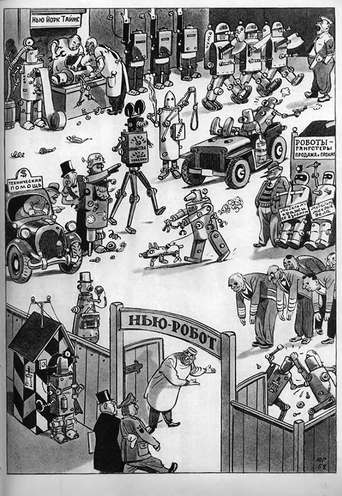
Source: geektimes.ru/post/249458/
Scientists who study the history of innovation, come to the conclusion that there are certain patterns in the innovative development of society. Every single time can be described S-curve on which there are periods of slow initial distribution, rapid and widespread decay. With these phases and cycles converge about economic growth, and found that Kondratiev. Study questions the theory perfected and now, one of the plurality of opinions can be described five waves of innovation (technological structures). Now we are on the threshold of the sixth order, the picture below shows the approximate time frame and related technologies:

The sixth wave of innovation is designated as the development of nanotechnology and nuclear power. Apparently, this forecast was chosen as a basic for the technological development of Russia, legs and RUSNANO project " Breakthrough "just grow out of it. Unfortunately, probably guessing about the timing and dynamics of the new structure, the forecast , in our humble opinion, coarsely missed in choosing technology. Under the scheme, since the end of the twentieth century, the information revolution begins with what we can not agree, whereas for the sixth order are chosen, for some reason, not information technology.
If we look at the current landscape of technology and think that now can change our lives as well as the steam engine and the microchip, we arrive at the conclusion that these are the information technology geeks. Let's see an example of one of the most sensational of this technology: the car-robot that can move without human intervention, created largely thanks to the symbiosis of machine learning and analyzing the huge amount of data. For example, here is a well-known, reminiscent smile Google car, behind which is already 1, 1 million kilometers in a technical prototype.

According to the estimates of their creators, he сократит the number of accidents and lost in suburban travel time by 90%. We add that the annual death rate from road accidents in the world is more than 1 million people, and the children is the main cause of death. If the machine will no longer be private transport, and become public, we can expect fold reduction in the vehicle fleet, because utilization of private cars is very low. In the example below you can see that even in the rush hour at most 17% cars are on the roads at the same time:

The horizontal - the time of day, vertical - the share of private vehicle to the road i>
The transition from private car to the taxi-robomobilyu will reduce the required number of vehicles, increasing their overall utilization, while less expensive cost of transportation. On the one hand, "public robomobilyu" confronts the inertia of human thinking, but on the other study показывают, it is commonplace in the cheaper one, 5-10 times and more convenient. Plus it west is the starting point of many social breakthroughs, such as open source software or human rights. Is a good tool and state regulation - for example, in Norway quarter selling cars - electric cars, and there is a car in Manhattan only every fourth жителя and the main transport - taxi.
All this leads to a change in optimal performance cars: instead of the usual five-seater petrol sedans, and for the United States and instead of pickups, relevant double mini-cars like the image above. They are cheaper to manufacture and require less energy to transport to and from work, which makes electricity for these vehicles is much more interesting option than it is now.
Inevitable and structural effects in the economy, the whole industry will become less relevant: it will take fewer gas stations, repair shops, car washes, insurance agents and insurance companies themselves, one of the automakers go bankrupt, or switch to the production of exclusive models for connoisseurs. Hospitals will be free, as will lose hundreds of thousands of patients; vacate the area occupied by parking lots - it will free space in cities for alternative uses; change the logistics industry - reduce the demand for the profession of drivers of all kinds, including couriers and trucks.

The most popular profession in the states (pale blue color truck drivers) i>
As a result of all these releases millions of workers and trillions of dollars in potential savings - you can conquer Mars and build undersea cities. Well, if you are a pessimist, we are waiting for millions of poor and unemployed, slipping into gangs and prey on robomobili privileged class. In any case, this is a truly revolutionary technology that will have an impact on society comparable to the replacement of the horse on the "Model T" from Ford. That's why this funny little car attracts the attention of economists and futurists of all kinds.
Analysts Morgan Stanley adhere to мнения, that this utopia we find ourselves in 2025, and the first fully self-contained models will be available within 3 years, in 2018. In the Audi добавляют, that in 2017 they have released a fully automatic A8, but the main problem is not technical but legal.

The development of autonomous technology TC i>
People hardly are nonexistent and especially benefit from it and consistently underestimate the possibility of progress. For those who are on the side of the monitor casually waving at our fantasies, we give examples of real commercial.
You can start with the history of confrontation between the two resource-oriented countries - Brazil and Australia. Both iron ore supply for the growing Chinese market (60% of world iron ore imports accounted for China). In Brazil, cheap labor and more saturated rock, but it is far away from China. Australia close, but has expensive labor. Competition led to optimization - Brazil reduces the cost of transportation costs through the construction of dry bulk fleet to unprecedented for its time scale of 400,000 tons deadweight. Dry cargo is so large that no port was not ready to accept them and they had to overload the ore off the coast of China's smaller ships.
Australian company Rio Tinto (third place among the world's mining companies) went through more advanced and has launched a program " mine of the future ". While Google and others are working on their prototypes, robotic autonomous 300-ton dump trucks Komatsu firms in the harsh conditions of the Australian desert has passed 4 million kilometers and transported 200 million tons of rock:

And "mine of the future" is not limited to: automatic drilling-mortgagors explosives, monitoring and control processes ore sorting, and now the program is now automated railway length of 1500 km with autonomous driverless trains. In general, these innovations helped to increase ore extraction, while saving the company 900 employees and significantly improve the working conditions of hundreds of others. It is worth noting that each truck drivers needed 4-5 with a salary of more than 100,000 dollars a year, and the driver got 240'000 dollars. The program does not stop there - expands the number of robots, trucks, etc., which will eventually lead to a decrease in the cost of technology and its spread to other mines around the world. Thus, if the success of Google's machine has yet to be proven empirically, the benefits of the truck in the picture above is already quite palpable and has a real economic result.
Despite vyshenapisannoe, predict the future no one has learned and scientific community, as always, is divided into pessimists and optimists. The former believe that the innovations of the near future are small relative to the two industrial and computer revolution and the current slow growth in labor productivity in the west will be delayed. The latter rely on the fact that mankind has always underestimates the potential of innovation. However, the mentioned innovations become the banner of the current decade, as they simply do not have time to implement any globally or individually west.
It is necessary to touch upon the topic of unemployment. There is a logical, at first glance, a causal relationship that robotics and other innovations will lead to mass unemployment, as the required number of workers will decrease. Fortunately, you can not be limited to theoretical arguments, and look directly at the empirical - 160 years of unemployment in Britain as a nation that gave birth to the Industrial Revolution:

It is clear that these 160 years, progress is not standing still and productivity increased by 10 times. However, it did not affect the growth of unemployment. There are two long and many short periods of unemployment, but these periods were short-lived and are not associated with technological change, and economic. The fact that automation and productivity growth not only destroy the jobs, but also creates new and the whole issue in the balance of these opposing processes, which generally supports. So now some professions will disappear, others will - the world does not stand still, it was and always will be. As a last resort you can always go to communism.

Source: geektimes.ru/post/249458/
VKontakte today launch a rival YouTube
Toyota touts hydrogen cars, saying that hydrogen is even in manure

